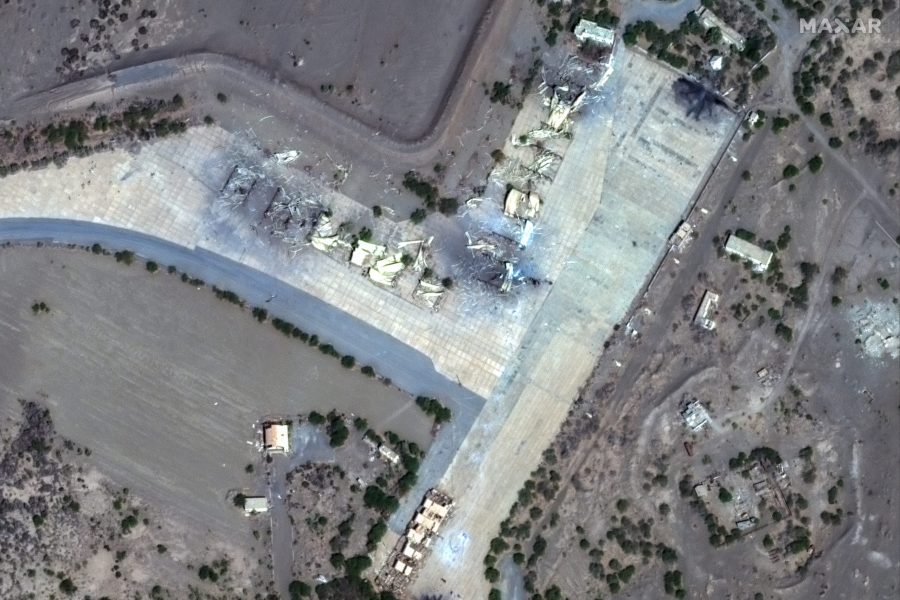U.S. and British forces have carried out airstrikes and sea-launched cruise missile attacks on nearly 30 locations in Houthi-controlled areas of Yemen, the Pentagon said Jan. 12, striking a dozen more sites than were previously revealed.
The additional strikes were conducted during the overnight hours of Jan. 12 and followed an initial wave of attacks that were intended to degrade the Houthis’ capabilities to attack shipping in the Red Sea, Director of Operations for the Joint Staff Lt. Gen. Douglas A. Sims II told reporters.
All told, more than 150 precision munitions were employed against more than 60 targets spread out over 28 locations, Sims said.
The initial wave of attacks were directed against “command and control nodes, munitions depots, launching systems, production facilities, and air defense radar systems,” Air Forces Central commander Lt. Gen. Alexus G. Grynkewich said in a statement. The follow-up attacks were more dynamic in nature, U.S. officials said.
“Based on the hostile act, hostile intent, a determination that those weapon systems would be employed against the maritime or air forces, and as a result, they struck those targets,” Sims said of the second wave of attacks, which occurred shortly after the first strikes.
That wasn’t the end of it. An additional “follow-on” strike was carried out against a Houthi radar site in Yemen in the early morning hours of Jan. 13 local time using Tomahawk cruise missiles from the destroyer USS Carney, U.S. Central Command said. The purpose was to neutralize a target that wasn’t fully destroyed in a previous strike, U.S. officials said.
The earlier strikes were carried out by U.S. Navy aircraft from the Carrier Air Wing Three on USS Dwight D. Eisenhower, the guided-missile destroyers USS Gravely and USS Mason, the guided-missile cruiser USS Philippine Sea, and an Ohio-class guided-missile submarine, Sims said.
The British government said four Royal Air Force Typhoons were involved in the strike and struck an airfield and a drone facility. U.S. Air Force assets were also involved, though officials did not specify which platforms.
The Houthis, an Iranian-backed group that controls most of Yemen, have carried out 28 attacks on commercial shipping since mid-November, with the latest occurring soon after the U.S. and U.K. strikes.
On Jan. 1, President Joe Biden asked for military options after a Dec. 31 clash in which Navy helicopters came to the rescue of a commercial vessel the Houthis were attacking and sank three small Houthi boats. The U.S. and 12 other countries then issued a joint statement on Jan. 3 warning of “consequences” if attacks continued. But that did not deter the Houthis, who on Jan. 9 mounted their largest attack yet, launching drones, as well as cruise and ballistic missiles.
“On Tuesday, Jan. 9, nearly 20 drones and multiple missiles were launched in multiple salvos directly against U.S. ships,” a senior administration official told reporters on Jan. 11. “This attack was defeated by the U.S. and UK naval forces working jointly as part of Operation Prosperity Guardian, the defensive coalition established last month in response to these attacks. If not for this defensive mission, we have no doubt that ships would have been struck, perhaps even sunk, including, in one case, a commercial ship full of jet fuel.”
After that attack, Biden convened a meeting of his national security team and directed Secretary of Defense Lloyd J. Austin III to carry out a military response, the official added.
“We will make sure we respond to the Houthis if they continue this outrageous behavior along with our allies,” Biden told reporters on Jan. 12.
Iran and the so-called Axis of Resistance militia groups Tehran arms have carried a range of strikes against U.S. forces and international shipping since the start of the Israel-Hamas war. Iranian-backed militias have carried out more than 130 attacks against U.S. troops in Iraq and Syria, while the Houthis have sought to attack Israel and commercial shipping.
The Biden administration says that its goal is to deter future attacks without broadening the fighting in the Middle East.
“This was a comprehensive strike intended to not only back up last week’s diplomatic statement but to do real damage to the Houthis’ ability to conduct more of these attacks,” former CENTCOM commander retired Army Gen. Joseph L. Votel told Air & Space Forces Magazine.
“In and of itself, it will probably be insufficient because it is likely the Houthis will attempt to test us again,” said Votel. “That means we need to be prepared to do it again and reinforce the message that we find these unprovoked attacks on shipping unacceptable.”
“Iran may try to test us as well and we need to be sending very clear messages that they should not do this,” Votel added. “We need all of our elements of national power being applied in a coherent strategy.”
Commercial and military vessels are at particular risk near Yemen because they must use Bab el-Mandeb strait to cross between the Red Sea and the Gulf of Aden, a critical chokepoint.
Nearly 15 percent of seaborne trade passes through the Red Sea, which connects to the Mediterranean Sea via the Suez Canal. Many commercial shippers have been forced to divert ships around the southern coast of Africa, causing significant delays and costs for the global economy, with some carmakers announcing halts in production. The White House said 2,000 ships have been forced to divert and more than 50 countries have been affected by the attacks.
“This cannot stand,” British Prime Minister Rishi Sunak added.
But U.S. officials said they were clear-eyed about the continuing Houthi threat.
“It seems within the DNA” to continue attacks, Sims said. “I would hope that they don’t retaliate, but we’re prepared in the event that they do,” he said.
